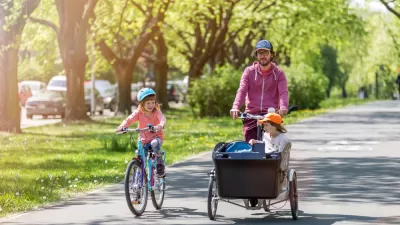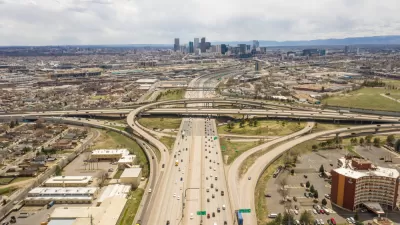The U.S. Census Bureau estimates that in 2007, over 9.8 million American households had no auto available at home. Although those car free households make up only 8.7% of the U.S., the split by housing ownership is striking: only 3.3% of owner occupied homes do without at least one vehicle, where fully 19.9% of renters have no cars parked in the proverbial driveway. For some, not owning a vehicle is not a matter of choice -- just the reality of limited resources. For others, it's a matter of preference, and many residents of cities with fairly good public transportation choosing to go without cars. Although car ownership is a useful indicator of neighborhoods that provide good options for public transit, the reality is the most important variable isn't whether you own one, but how much you drive. That's the idea behind the annual Car-Free Challenge sponsored by the San Francisco Bay Area nonprofit TransForm (formerly TALC - Transportation and Land Use Coalition). The Challenge's over 160 participants pledged to drive less than 125 miles in June, much less than the Bay Area average of 540, or the U.S. average of over 1,000. Many participants contributed blog posts about their experiences on the Challenge website. More than just a group of footloose young professionals living in The Mission, challenge participants were remarkably diverse group living mostly in the Bay Area but also Sacramento, Los Angeles, and cities outside of California.
The U.S. Census Bureau estimates that in 2007, over 9.8 million American households had no auto available at home. Although those car free households make up only 8.7% of the U.S., the split by housing ownership is striking: only 3.3% of owner occupied homes do without at least one vehicle, where fully 19.9% of renters have no cars parked in the proverbial driveway.
For some, not owning a vehicle is not a matter of choice -- just the reality of limited resources. For others, it's a matter of preference, and many residents of cities with fairly good public transportation choosing to go without cars. Although car ownership is a useful indicator of neighborhoods that provide good options for public transit, the reality is the most important variable isn't whether you own one, but how much you drive.
That's the idea behind the annual Car-Free Challenge sponsored by the San Francisco Bay Area nonprofit TransForm (formerly TALC - Transportation and Land Use Coalition). The Challenge's over 160 participants pledged to drive less than 125 miles in June, much less than the Bay Area average of 540, or the U.S. average of over 1,000. Many participants contributed blog posts about their experiences on the Challenge website. More than just a group of footloose young professionals living in The Mission, challenge participants were remarkably diverse group living mostly in the Bay Area but also Sacramento, Los Angeles, and cities outside of California.
As expected, many of the posts illustrate just how limited our public transit options are, and just how different the city is to experience without a car. One participant observed an 11 mile trip in San Jose took an hour and a half by transit -- and they didn't even miss a connection. Kirsten Gronfield, an actress in Burbank, was frustrated to find the best way to take transit to the Dodgers game ten miles away was also an hour and a half bus ride. Some found the challenge was enjoyable, finding they enjoyed the exercise and unexpected pleasures of walking or biking. One mother, traveling late at night on the BART with two small children and her mother found it resulted in additional quality family time, and the opportunity to bump into a friend.
Through surveys and complicated computer models, planners attempt to estimate our preferences for driving when provided alternative modes. Although there may be important market distortions at play, the overall pattern of auto dependence is undeniable. A growing body of evidence is developing that shows urban form -- and the quality of transit available -- can change people's habits. However, these changes are expensive, controversial, difficult and require decades to fully implement.
Although physical form is important, travel patterns are fundamentally based on millions of decisions made by regular people each day. These decisions can change when prices fluctuate, the city form or transit changes, or, like this group of 160 intrepid participants, people decide to change their behavior. On this point, Berkeley teenager and Car-Free Challenge participant Lang Miller can provide us some perspective.
A member of her school's Mountain Bike Team (this is California, after all), Lang didn't think twice about joining the car free challenge. "When my parents were my age they lived out in the 'burbs and had to drive to get places," she writes, "but my generation has watched An Inconvenient Truth in class and had school projects on carbon emissions. ... We are of a newer and more educated generation, and have been taught that cars are not entirely necessary to our existence." If she's right, the result could be quite different statistics indeed.

Trump Administration Could Effectively End Housing Voucher Program
Federal officials are eyeing major cuts to the Section 8 program that helps millions of low-income households pay rent.

Planetizen Federal Action Tracker
A weekly monitor of how Trump’s orders and actions are impacting planners and planning in America.

Ken Jennings Launches Transit Web Series
The Jeopardy champ wants you to ride public transit.

Washington Legislature Passes Rent Increase Cap
A bill that caps rent increases at 7 percent plus inflation is headed to the governor’s desk.

From Planning to Action: How LA County Is Rethinking Climate Resilience
Chief Sustainability Officer Rita Kampalath outlines the County’s shift from planning to implementation in its climate resilience efforts, emphasizing cross-departmental coordination, updated recovery strategies, and the need for flexible funding.

New Mexico Aging Department Commits to Helping Seniors Age ‘In Place’ and ‘Autonomously’ in New Draft Plan
As New Mexico’s population of seniors continues to grow, the state’s aging department is proposing expanded initiatives to help seniors maintain their autonomy while also supporting family caregivers.
Urban Design for Planners 1: Software Tools
This six-course series explores essential urban design concepts using open source software and equips planners with the tools they need to participate fully in the urban design process.
Planning for Universal Design
Learn the tools for implementing Universal Design in planning regulations.
Heyer Gruel & Associates PA
Ada County Highway District
Institute for Housing and Urban Development Studies (IHS)
City of Grandview
Harvard GSD Executive Education
Toledo-Lucas County Plan Commissions
Salt Lake City
NYU Wagner Graduate School of Public Service






























